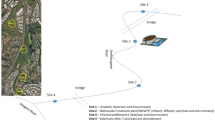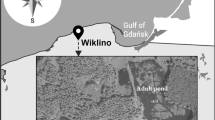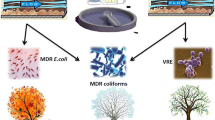Abstract
The efficiency of stabilization pond treatment of domestic wastewater in removing culturable cells of motile Aeromonas and its influence on the incidence of resistance to seven antibiotics were investigated in this study. Removal efficiency was higher (P < 0.001) in the warm months (98.8%) than in the cold months (97%). Among the 264 isolates, 163 were Aeromonas caviae, 24 were A. hydrophila, and 54 were A. sobria. Twenty-three isolates could not be identified to the species level. In the influent, A. caviae dominated in both cold and warm months. In the water samples originating from the influent, A. sobria was present at higher percentages in the warm period. All the isolates were resistant to amoxicillin and most of them (73%) exhibited resistance to cephalothin. Of the three species tested, A. sobria was more susceptible to antibiotics than either A. caviae or A. hydrophila. The most striking difference among the species was seen in resistance to cephalothin. There were 91 % of A. caviae strains and 96% of A. hydrophila isolates that were resistant to cephalothin. However, only 9% of A. sobria strains exhibited resistance to this drug. The high incidence of resistance in raw sewage was connected with a high proportion of A. caviae, whereas in the water samples collected from the effluent during the warm months, a high proportion of A. sobria decreased the total amount of multiple-resistant bacteria. Results demonstrated the need for identification to the species level.
Similar content being viewed by others
References
Altwegg M (1985) Aeromonas caviae: An enteric pathogen? Infection 13:228–230
Aubert M, Pesando D, Gauthier MJ (1975) Effects of antibiosis in a marine environment. In: Gameson A (ed) Discharge of sewage from sea outfalls. Pergamon Press, London, pp 191–197
Baine WB, Farmer JJ, Gangerosa EJ, Hermann GT, Thornsberry C, Rice PA (1977) Typhoid fever in the United States associated with the 1972–73 epidemic in Mexico. J Infect Dis 135: 649–653
Bauer AW, Kirby WHM, Sherris JC, Turck M (1966) Antibiotic susceptibility testing by a standardized single disk method. Am J Clin Pathol 36:493–496
Bell JB, Elliott GE, Smith DW (1983) Influence of sewage treatment and urbanization on selection of multiple resistance in fecal coliform populations. Appl Environ Microbiol 46: 227–232
Bell RG (1978) Antibiotic resistance patterns of fecal coliforms isolated from domestic sewage before and after treatment in an aerobic lagoon. Can J Microbiol 48:865–867
Bianchi MAG, Bianchi AIM (1982) Statistical sampling of bacterial strains and its use in bacterial diversity measurement. Microb Ecol 8:61–69
Boussaid A, Baleux B, Hassani L, Lesne J (1991) Aeromonas species in stabilization ponds in the arid region of Marrakech (Morocco). Relation to fecal-pollution and climatic factors. Microb Ecol 21:11–20
Champsaur H, Andremont A, Mathieu D, Rottman E, Auzepy P (1982) Cholera-like illness due to Aeromonas sobria. J Infect Dis 145:248–254
Chang BJ, Bolton SM (1987) Plasmids and resistance to antimicrobial agents in Aeromonas sobria and Aeromonas hydrophila clinical isolates. Antimicrob Agents Chemother 31:1281–1282
Daily OP, Joseph SW, Coolbaugh JC, Walker RI, Merrell BR, Rollins DM, Seidler RJ, Colwell RR, Lissner CR (1981) Association of Aeromonas sobria with human infections. J Clin Microbiol 13:769–777
Demillac R, Baron D, Maurin J (1987) Décontamination bactérienne et virale en bassins de lagunage naturel: Cas de la Chapelle Thouarault. Trib Cebedeau 40:33–39
Dodin A, Dosso M, Nicolas R, Guillou M (1982) Sensibilité des souches microbiennes aérobies responsables de diarrhées infectieuses outremer à deux substances chimiques: La trimethoprime sulfaméthoxazole et la 5-methyl-oxine. Bull Soc Pathol Ex 75:453–460
Fainstein V, Weaver S, Body GP (1982) In vitro susceptibilities of Aeromonas hydrophila against new antibiotics. Antimicrob Agents Chemother 22:513–514
Fass R, Barnishan J (1981) In vitro susceptibilities of Aeromonas hydrophila to 32 antimicrobial agents. Antimicrob Agents Chemother 19:357–358
Fliermans CB, Groden RW, Hazen TC, Esch GW (1977) Aeromonas distribution and survival in a thermally altered lake. Appl Environ Microbiol 41:657–663
Fujioka RS, Narikawa OT (1982) Effect of sunlight on enumeration of indicator under field conditions. Appl Environ Microbiol 44:395–401
Gangarosa EJ, Bennett JV, Wyatt C, Pearce PE, Olarte J, Hernandes PM, Bazquez B, Bessudo P (1972) An epidemic associated episome. J Infect Dis 126:215–218
Grabow WOC, Zyl VM, Prozeski OW (1976) Behaviour in conventional sewage purification processes of coliform bacteria with transferable or non-transferable drug-resistance. Water Res 10:717–723
Grimes DJ (1975) Release of sediment-bound fecal coliforms dredging. Appl Microbiol 29: 109–111
Havelaar AH, During M, Versteegh JFM (1987) Ampicillin-dextrin agar medium for the enumeration of Aeromonas species in water by membrane filtration. J Appl Bacteriol 62: 279–287
Hazen TC, Fliermans CB (1979) Distribution of Aeromonas hydrophila in natural and manmade thermal effluents. Appl Environ Microbiol 38:166–168
Hazen TC, Fliermans CB, Hirsch RP, Esch GW (1978) Prevalence and distribution of Aeromonas hydrophila in the United States. Appl Environ Microbiol 36:731–738
Hinton M, Linton AH (1983) Antibacterial drug resistance among Escherichia coli isolated from calves fed on a milk substitute diet. Vet Rec 112:567–568
Janda JM, Motyl MR (1986) Cephalothin susceptibility as a potential marker for the Aeromonas sobria group. J Clin Microbiol 19:44–47
Kaper JB, Lockman H, Colwell RR, Joseph SW (1981) Aeromonas hydrophila: Ecology and toxigenicity of isolates from an estuary. J Appl Bacteriol 50:359–377
Kapuscinski R, Mitchell R (1981) Solar radiation induces sublethal injury in Escherichia coli in seawater. Appl Environ Microbiol 41:670–674
LeChevallier MW, Evans TM, Seidler RJ, Daily OP, Merrel BR, Rollins DM, Joseph SW (1982) Aeromonas sobria in chlorinated drinking water supplies. Microb Ecol 8:325–333
Leclerc HF, Mizon B, Boniface B, Boniface M (1977) Eau et bactéries résistanes aux antibiotiques: Étude écologique. Ann Microbiol (Inst Pasteur) 128B:253–269
Legendre L, Legendre P (1979) Ecologie numérique, vol. 2. Masson, Paris
Leroux G, Giraud-Carles D, Chabbert JM (1982) Fréquence du genre Aeromonas en milieu hospitalier: A propos de l'isolement de 9 souches au cours du second semestre 1980. Medecine et Maladies Infectieuses 12:46–49
Lesne J, Baleux B, Boussaid A, Hassani L (1991) Dynamics of non-01 Vibrio cholerae in experimental sewage stabilization ponds under and mediterranean climate. Wat Sci Technol 22:387–390
McCambridge J, McKeekin TA (1981) Effect of solar radiation and predacious microorganisms on survival of fecal and other bacteria. Appl Environ Microbiol 41:1083–1087
McNicol LA, Aziz KMS, Huq I, Kaper JB, Lockman HA, Remmers EF, Spira WM, Voll MJ, Colwell RR (1980) Isolation of drug-resistant Aeromonas hydrophila from aquatic environments. Antimicrob Agents Chemother 17:477–483
Mizon FM, Gerbaud GR, Leclerc H, Chabbert YA (1978) Présence de plasmides de résistance appartenant au groupe d'incopmatibilité C chez Aeromonas hydrophila isolé des eaux rési-duaires. Ann Microbiol (Inst Pasteur) 129B:19–26
Morozzi G, Sportolari R, Caldini G, Cenci G, Morosi A (1988) The effect of anaerobic and aerobic wastewater treatment on faecal coliforms and antibiotic-resistant faecal coliforms. Zbl Bakt Hyg B185:340–349
Motyl MR, McKinly G, Janda JM (1985) In vitro susceptibilities of Aeromonas hydrophila, Aeromonas sobria, and Aeromonas caviae to 22 antimicrobial agents. Antimicrob Agents Chemother 28:151–153
Overman TL (1980) Antimicrobial susceptibility of Aeromonas hydrophila. Antimicrob Agents Chemother 17:612–614
Palumbo SA, Maxino F, Williams AE, Buchmann RL, Thayer DW (1985) Starch-ampicillin agar for the quantitative detection of Aeromonas hydrophila. Appl Environ Microbiol 50: 1027–1030
Popoff M, Veron M (1976) A taxonomic study of the Aeromonas hydrophila—Aeromonas punctata group. J Gen Microbiol 94:15–22
Rippey SR, Cabelli VJ (1979) Membrane filter procedure for enumeration of Aeromonas hydrophila in fresh water. Appl Environ Microbiol 38:108–113
Rippey SR, Cabelli VJ (1980) Occurence of Aeromonas hydrophila in limnetic environments: Relationship of the organism to trophic state. Microb Ecol 6:45–54
Rogol M, Sechter I, Grinberg L, Gerichter CB (1979) Pril-xylose-ampicillin agar, a new selective medium for the isolation of Aeromonas hydrophila. J Med Microbiol 12:229–231
San Joaquin VH, Scribner RK, Pickett DA, Welch DF (1986) Antimicrobial susceptibility of Aeromonas species isolated from patients with diarrhea. Antimicrob Agents Chemother 30: 794–795
Seidler RJ, Allen DA, Lockman H, Colwell RR, Joseph SW, Daily OP (1980) Isolation, enumeration, and characterization of Aeromonas from polluted waters encountered in diving operations. Appl Environ Microbiol 39:1010–1018
Sturtevant AB, Feary TW (1969) Incidence of infectious drug resistance among lactose-fermenting bacteria isolated from raw and treated sewage. Appl Microbiol 18:918–924
Zeaur R, Sanyal SC, Aziz KMS, Huq I, Chowdhury AA (1984) Isolation of enterotoxigenic, hemolytic, and antibiotic-resistant Aeromonas hydrophila strains from infected fish in Bangladesh. Appl Environ Microbiol 48:865–867
Author information
Authors and Affiliations
Additional information
Offprint requests to: L. Hassani.
Rights and permissions
About this article
Cite this article
Hassani, L., Imziln, B., Boussaid, A. et al. Seasonal incidence of and antibiotic resistance among Aeromonas species isolated from domestic wastewater before and after treatment in stabilization ponds. Microb Ecol 23, 227–237 (1992). https://doi.org/10.1007/BF00164098
Received:
Revised:
Issue Date:
DOI: https://doi.org/10.1007/BF00164098




